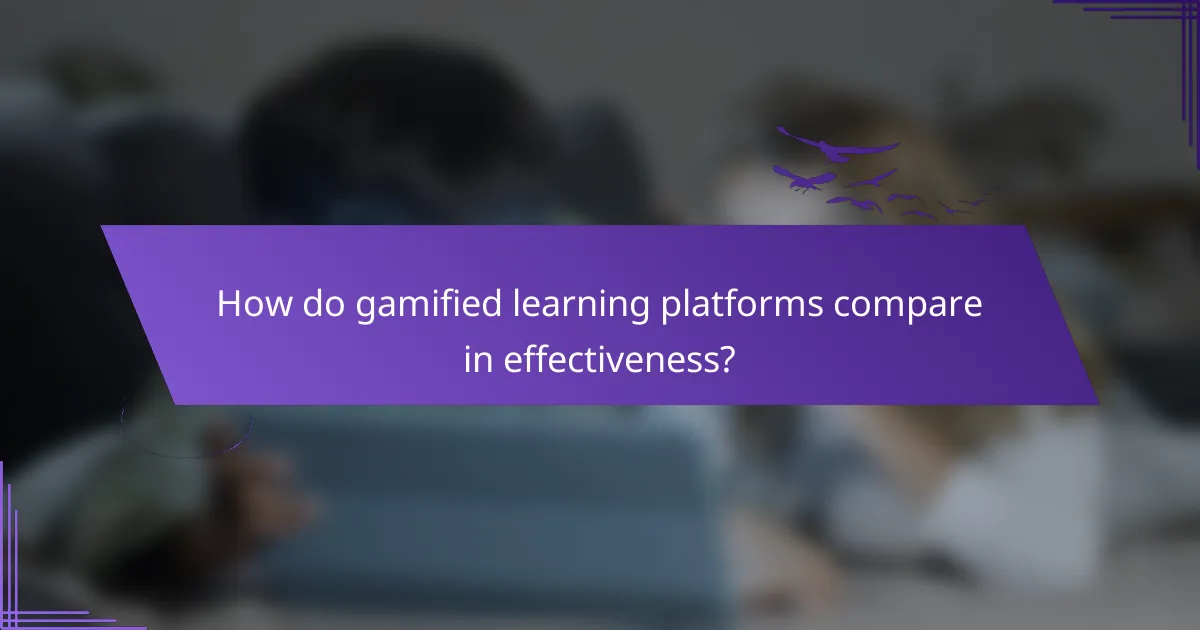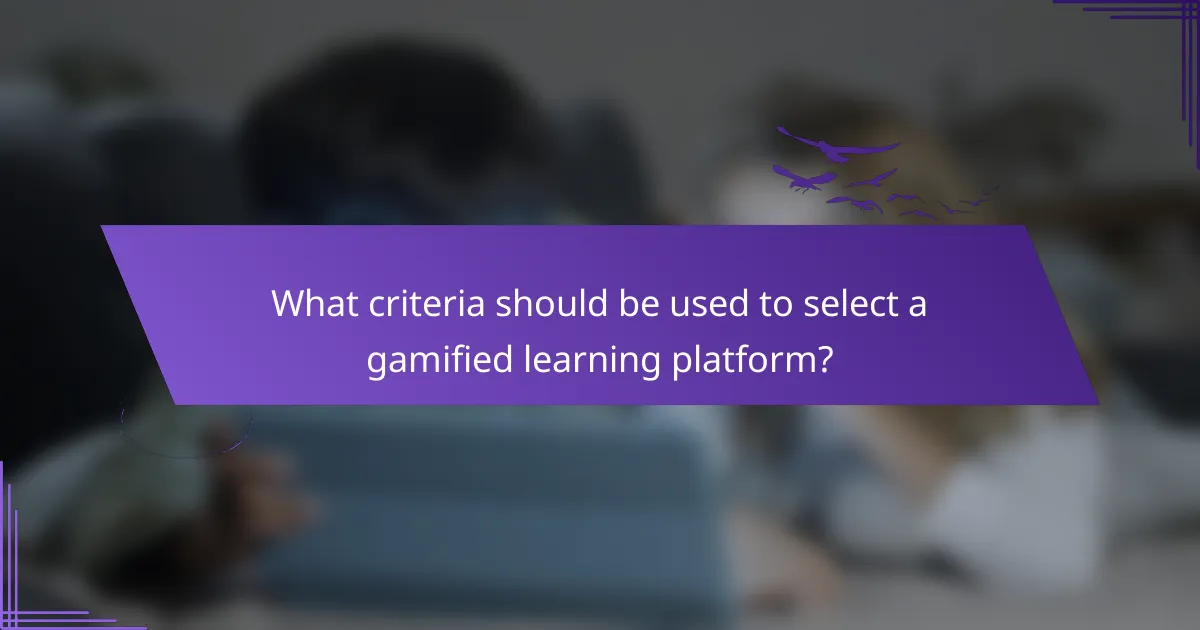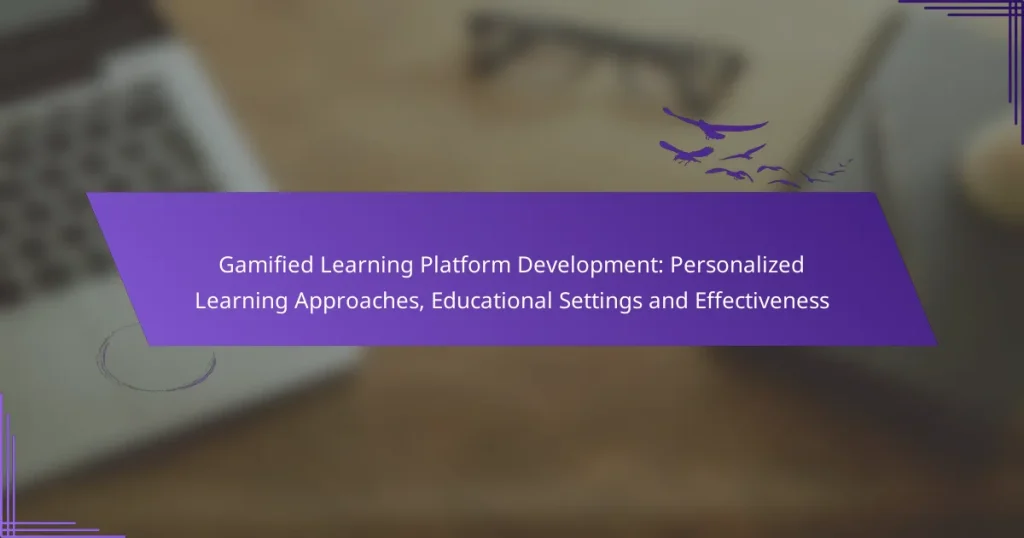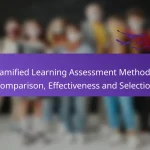Gamified learning platforms revolutionize education by incorporating game mechanics that tailor experiences to individual learning preferences and styles. By fostering engagement and motivation, these platforms significantly enhance knowledge retention and educational outcomes across various settings, including K-12 schools, higher education, and corporate training programs.

How can gamified learning platforms enhance personalized learning?
Gamified learning platforms enhance personalized learning by integrating game mechanics that cater to individual user preferences and learning styles. These platforms create engaging experiences that adapt to each learner’s needs, ultimately improving knowledge retention and motivation.
Increased engagement through interactive elements
Interactive elements such as quizzes, challenges, and simulations significantly boost learner engagement. By incorporating these features, learners are more likely to participate actively rather than passively consuming information.
For instance, platforms can use leaderboards and badges to foster a sense of competition and achievement. This gamification encourages users to complete tasks and explore content more thoroughly, enhancing their overall learning experience.
Adaptive learning paths based on user performance
Adaptive learning paths tailor the educational journey based on the learner’s performance and preferences. By analyzing data on how users interact with the content, these platforms can adjust the difficulty level and type of material presented.
This personalization ensures that learners are neither bored with material that is too easy nor overwhelmed by content that is too challenging. For example, if a student excels in math but struggles with reading, the platform can offer more advanced math challenges while providing additional reading resources.
Real-time feedback and rewards
Real-time feedback allows learners to understand their progress immediately, reinforcing their learning and guiding them on areas needing improvement. Instant feedback mechanisms can include automated quizzes that provide scores and explanations right after completion.
Additionally, rewards such as points, badges, or unlockable content serve as motivation for learners to engage consistently. These incentives can lead to higher completion rates and a more positive attitude toward learning, as users feel recognized for their efforts.

What are the key features of effective gamified learning platforms?
Effective gamified learning platforms incorporate several key features that enhance user engagement and educational outcomes. These features include progress tracking, social learning components, and customizable content, all of which contribute to a more personalized learning experience.
Progress tracking and analytics tools
Progress tracking and analytics tools are essential for monitoring learner engagement and performance. These tools provide insights into user activity, allowing educators to identify strengths and areas needing improvement. For instance, platforms may offer dashboards that display completion rates, time spent on tasks, and scores on assessments.
When implementing these tools, consider using visual representations like graphs or charts to make data interpretation easier for both learners and instructors. Regularly reviewing analytics can help tailor learning paths and interventions, ensuring that each learner receives the support they need.
Social learning and collaboration features
Social learning and collaboration features foster interaction among learners, enhancing the educational experience. These may include discussion forums, group projects, or peer review systems that encourage knowledge sharing and teamwork. For example, platforms can integrate chat functions or collaborative workspaces where users can discuss concepts in real-time.
To maximize the effectiveness of these features, ensure that they are user-friendly and accessible. Encourage participation by setting up group challenges or competitions that leverage social dynamics, which can motivate learners to engage more deeply with the content.
Customizable content and learning experiences
Customizable content and learning experiences allow educators to tailor materials to meet diverse learner needs. This can involve adjusting difficulty levels, selecting specific topics, or incorporating multimedia elements like videos and interactive quizzes. Personalization helps maintain learner interest and can lead to better retention of information.
When designing customizable features, consider providing options for learners to choose their learning paths or set personal goals. This autonomy can significantly boost motivation and engagement, making the learning experience more relevant and effective for each individual.

Which educational settings benefit most from gamified learning?
Gamified learning is particularly effective in K-12 schools, higher education institutions, and corporate training programs. These educational settings leverage game mechanics to enhance engagement, motivation, and skill acquisition among learners.
K-12 schools integrating technology
K-12 schools that incorporate technology into their curricula see significant benefits from gamified learning. By using game elements like points, badges, and leaderboards, educators can create a more interactive and motivating environment for students. This approach can lead to improved attendance and participation rates.
For example, platforms that allow students to earn rewards for completing assignments or mastering skills can foster a sense of achievement. Teachers should consider integrating gamified elements gradually, ensuring that they align with educational goals and standards.
Higher education institutions focusing on engagement
Higher education institutions can enhance student engagement through gamified learning strategies. By incorporating simulations, role-playing, and competitive elements into courses, universities can make complex subjects more accessible and enjoyable. This method can lead to deeper understanding and retention of material.
For instance, a business course might use a simulation game where students manage a virtual company, making decisions based on real-world scenarios. Institutions should evaluate the effectiveness of gamified approaches regularly, adjusting them based on student feedback and learning outcomes.
Corporate training programs for skill development
Corporate training programs benefit from gamified learning by making skill development more engaging and effective. Companies can use gamification to encourage employees to complete training modules, track their progress, and compete with colleagues. This not only boosts motivation but also enhances knowledge retention.
For example, a sales training program might include a leaderboard showcasing top performers, incentivizing employees to improve their skills. Organizations should ensure that gamified elements are relevant to job roles and provide meaningful rewards to maintain interest and participation.

How do gamified learning platforms compare in effectiveness?
Gamified learning platforms generally show higher effectiveness in educational settings compared to traditional methods. They engage learners through game-like elements, leading to better retention, satisfaction, and motivation.
Higher retention rates compared to traditional methods
Gamified learning platforms often result in significantly higher retention rates than conventional educational approaches. By incorporating interactive elements, such as quizzes and challenges, learners are more likely to remember information. Studies suggest that retention can improve by 20-30% when gamification is effectively implemented.
For example, platforms that use point systems and rewards encourage repeated engagement, reinforcing learning material. This active participation helps solidify knowledge in long-term memory, making it easier for learners to recall information later.
Improved learner satisfaction and motivation
Gamified learning platforms enhance learner satisfaction and motivation through engaging content and interactive experiences. Features such as leaderboards, badges, and progress tracking create a sense of achievement, which can significantly boost motivation levels.
Research indicates that learners using gamified systems report higher levels of enjoyment and commitment to their studies. This increased engagement often translates into better academic performance and a more positive attitude towards learning.
Case studies from successful implementations
Numerous case studies highlight the effectiveness of gamified learning platforms across various educational settings. For instance, a university in the United States implemented a gamified system for its introductory biology course, resulting in a 25% increase in student engagement and a notable improvement in exam scores.
Another example is a corporate training program that utilized gamification to enhance employee skills. Participants reported a 40% increase in knowledge retention and a 30% improvement in job performance, demonstrating the potential of gamified learning in professional development.

What criteria should be used to select a gamified learning platform?
When selecting a gamified learning platform, prioritize alignment with educational goals, user interface quality, and accessibility features. These criteria ensure that the platform effectively supports personalized learning experiences and meets the needs of diverse learners.
Alignment with learning objectives
Choose a gamified learning platform that aligns closely with your educational objectives. This means the platform should support specific learning outcomes, whether they are skill acquisition, knowledge retention, or behavioral changes.
Consider platforms that offer customizable content and adaptive learning paths. For example, a platform that adjusts difficulty based on learner performance can enhance engagement and effectiveness.
User interface and accessibility considerations
The user interface should be intuitive and engaging to facilitate a positive learning experience. Look for platforms that offer clear navigation, visually appealing design, and interactive elements that keep learners motivated.
Accessibility is crucial; ensure the platform complies with relevant standards, such as WCAG, to accommodate users with disabilities. Features like text-to-speech, adjustable font sizes, and keyboard navigation can enhance usability for all learners.

What are the emerging trends in gamified learning platform development?
Emerging trends in gamified learning platform development focus on personalized learning approaches, integration of advanced technologies, and enhanced engagement strategies. These trends aim to create more effective educational experiences tailored to individual learner needs.
Personalized Learning Approaches
Personalized learning approaches in gamified platforms adapt content and experiences to meet the unique needs of each learner. This can include tailored pathways, where learners progress through material at their own pace, and adaptive assessments that adjust difficulty based on performance.
For example, platforms may use algorithms to analyze user data and suggest specific challenges or resources that align with a learner’s strengths and weaknesses. This customization enhances motivation and retention, as learners feel more in control of their educational journey.
Educational Settings
Gamified learning platforms are being increasingly adopted in various educational settings, including K-12 schools, higher education institutions, and corporate training environments. Each setting has unique requirements and challenges that gamification can address, such as fostering collaboration in classrooms or enhancing skill development in the workplace.
In K-12 settings, gamification can make learning more engaging through interactive elements like badges and leaderboards, while in corporate training, it can facilitate knowledge retention and application through simulations and role-playing scenarios.
Effectiveness
The effectiveness of gamified learning platforms is often measured by improvements in learner engagement, knowledge retention, and overall performance. Research indicates that gamified elements can lead to higher motivation levels, with many learners reporting increased enjoyment and commitment to their studies.
To maximize effectiveness, educators and developers should focus on clear learning objectives, appropriate game mechanics, and regular feedback. Common pitfalls include overcomplicating the game elements or failing to align them with educational goals, which can detract from the learning experience.


